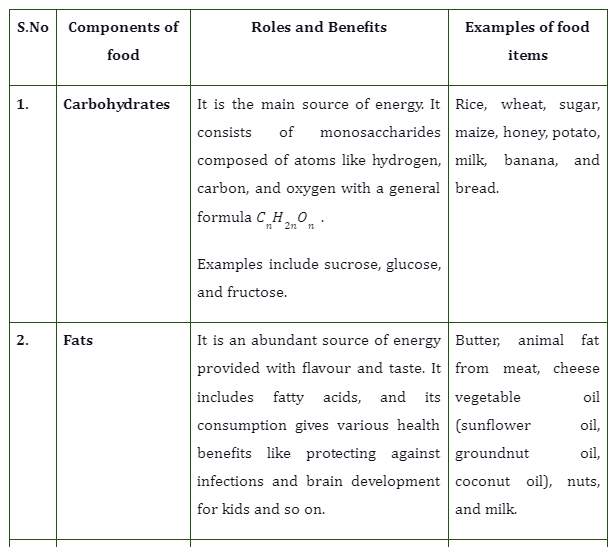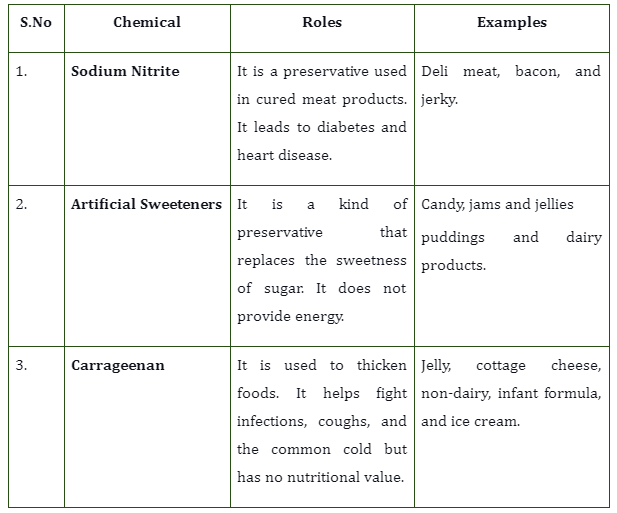Introduction
The term “food chemistry” is used to describe the study of the chemical reactions that take place in the preparation and consumption of food. The composition and functional qualities of foods and food products at different stages are the primary areas of study. While food supplies important elements such proteins, carbs, fats, vitamins, lipids, and minerals. The right nutrients should be included in the diet. Plants and animals are both examples of sources that can be used to create food. Because of the biochemical process it triggers in the body, this food is a rich source of fuel. Sugar, a simple type of carbohydrates, is converted into energy during respiration. Response as follows:

Enzymes and preservatives like flavours, food additives, and colours are also found in food. Manufacturers add preservatives and create new food variations to extend the shelf life of these products. Preservatives extend the shelf life of food without adding any nutritional value, similar to how milk is transformed by fermentation or enzymatic action into curd and cheese. Because of this, food science and chemistry have a positive effect on a wide range of aspects, including:
- Techniques for enhancing food’s shelf-life and avoiding the activity of microbes.
- Methods for food processing and avoiding food deterioration.
- Most importantly, food safety and quality enhancer methods.
What is Food Chemistry?
It alludes to the chemical composition of the meal and all of the interactions it has with the body and the environment. Chemical composition, how it is altered by cooking, and how it reacts with the human body are all topics covered. Proteins, carbs, and lipids can all be found in their purest forms in biological items like milk, meat, lettuce, poultry, and so on. Hence, food chemistry is concerned with all modifications made to foods and the improvement of their quality through various methods of food processing.

Chemical in Food
What do Food Chemists do?
A good food chemist should know the science behind food and its application.
- He should be able to develop improved food and beverages.
- He should be able to analyse methods like canning, heat processing, freezing, and packaging.
- He must be aware of the effects of processing on the taste, appearance, freshness, aroma, and vitamin and mineral content of food.
Components of Food
The main component is the necessary diet that is required in a large amount by the body.



Different Chemicals in Food
The other components or chemicals of food help in various functions of the body and their small quantities are enough.

Other chemicals listed below as preservatives added to food are unhealthy.

Food Components Can Be Broadly Differentiated Into Two Categories.
The food components are divided into two categories: Macronutrients and Micronutrients.

Summary
To learn about the science behind the components of food and their qualities, one must study food chemistry, a large field. It goes through every conceivable structural and molecular shift. A food chemist can oversee these modifications to ensure they don’t compromise the food’s safety or nutritional value in any way. In order for the body to develop and function normally, it need a diet that is both varied and complete.
Frequently Asked Questions
1. Why are preservatives bad for food?
Ans: Some chemicals (present in preservatives) can cause toxic effects like kidney damage, liver disease, DNA damage or impairment of the nervous system, and gastrointestinal symptoms.
2. What is an alternative for no chemical food?
Ans: Organic food is an alternative, since it has no chemicals like pesticides or artificial fertilisers.
3. Why does organic foods spoil faster?
Ans: Organic food is healthy as they are not treated with preservatives or waxes. Therefore, due to the absence of chemicals or preservatives, the shelf life of food decreases and spoils the food at a faster rate.
 Mission Statement
Mission Statement
“Empower every student to achieve full potential”
88Guru has been established with the social objective of making quality video-based learning material available to all Indian students. Technology, Connectivity and Social Media are rapidly changing the world of Education and we wish to lead the transformation of the tuition industry in India.
88Guru is the perfect complement to the current tuition model. 88Guru creates a wonderful opportunity for children and parents to bond while engaging in a valuable learning activity. It also provides the complete curriculum at your fingertips for those moments when you need some help at short notice. We believe that this mode of tuition could be transformational, adding hours to a child's day while providing complete control over the learning process.
Every course is taught by the best teachers from India's top schools and conducted in an engaging manner to keep students involved. The e-learning process consists of video-based instructions, computer-graded assignments, and a dashboard which allows the student and parent to track progress.


